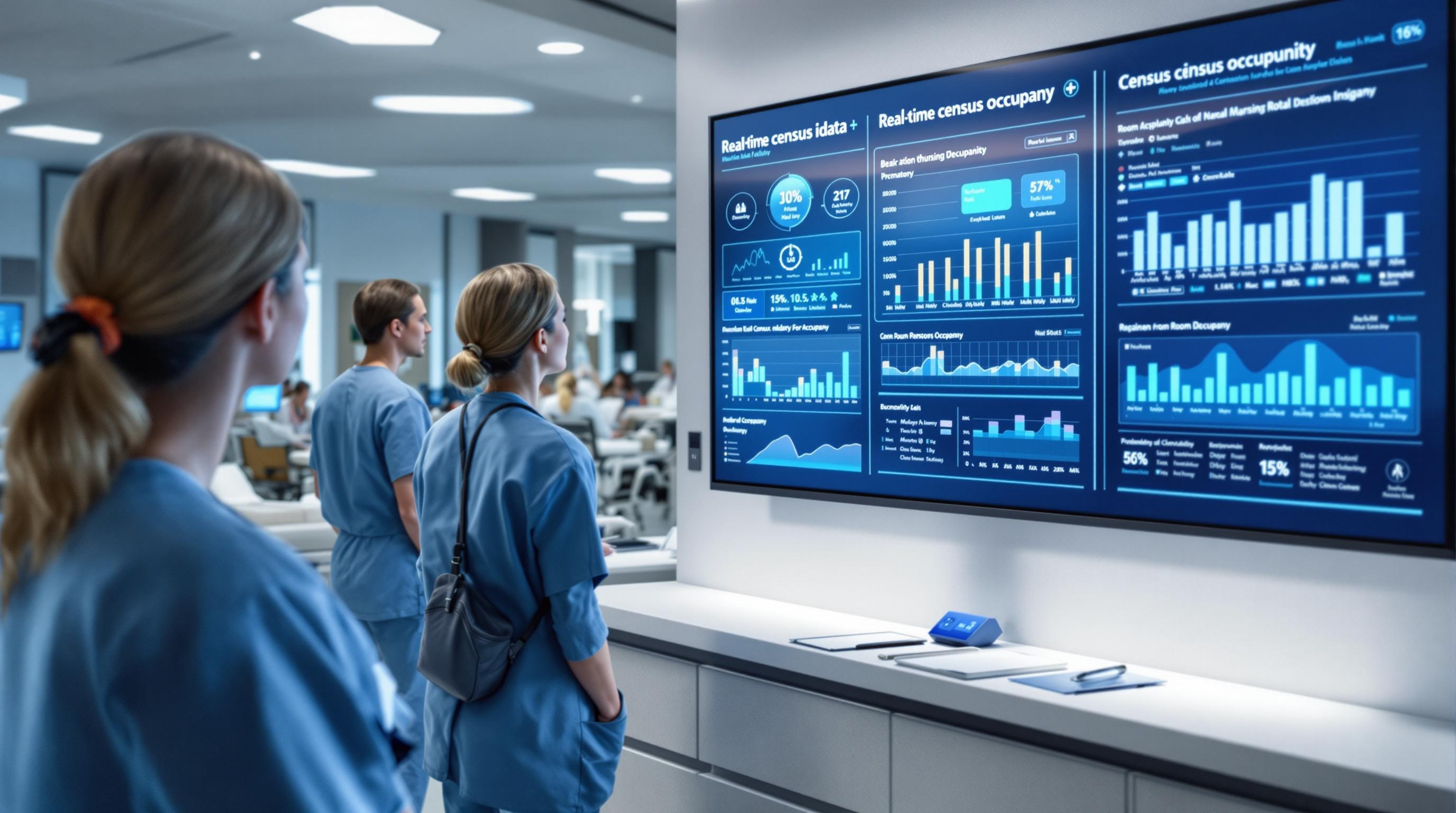Real Time Census Management for Skilled Nursing Facilities
Discover how real time census management streamlines skilled nursing facility operations, boosts occupancy, and supports data-driven decision making.
Quick Navigation
- 1. Introduction
- 2. Current Challenges in Real Time Census Management
- 3. How Sparkco AI Transforms Real Time Census Management
- 4. Measurable Benefits and ROI
- 5. Implementation Best Practices
- 6. Real-World Examples
- 7. The Future of Real Time Census Management
- 8. Conclusion & Call to Action
1. Introduction
As we head into 2025, skilled nursing facilities (SNFs) face a pivotal moment of both challenge and opportunity. According to recent industry analyses, census levels in many facilities have dropped by as much as 10% since 2020, with ongoing staffing shortages and regulatory changes adding further complexity to daily operations. Yet, as the sector recovers, leaders are increasingly turning to innovative strategies to rebuild census and ensure financial sustainability.
One of the most pressing issues for SNFs today is managing census in real time. In a landscape where every bed and every minute counts, outdated census tracking methods can lead to missed opportunities, inefficient admissions, and revenue loss. The pressure to accommodate higher-acuity residents, adapt to fluctuating demand, and comply with new value-based purchasing programs makes accurate, up-to-the-minute census data not just a convenience, but a necessity.
This article explores real time census management—what it is, why it matters, and how leading facilities are leveraging technology and data analytics to stay ahead. We’ll examine the latest trends shaping census management, the operational and financial impacts of delayed or inaccurate census data, and practical solutions that empower SNF teams to optimize occupancy, streamline workflows, and enhance patient care. Whether you’re a facility administrator, clinical leader, or healthcare IT professional, understanding real time census management is fast becoming essential for success in today’s skilled nursing environment.
2. Current Challenges in Real Time Census Management
Real-time census management—the ability to accurately track and manage patient occupancy, admissions, discharges, and transfers at any given moment—remains a critical yet complex challenge for healthcare facilities. As patient populations fluctuate and regulatory demands grow, many organizations struggle to maintain accurate, up-to-date census data. Below are the key pain points facing providers today, supported by recent research and data.
-
1. Fragmented Data Systems
Many facilities operate with disparate electronic health record (EHR) systems and legacy applications that do not seamlessly communicate. According to a 2023 ONC report, only 46% of post-acute care providers have fully interoperable EHRs, making real-time data sharing and census accuracy a persistent challenge. -
2. Manual and Error-Prone Processes
Census management often relies on manual entry and paper-based workflows. The Journal of Medical Internet Research highlights that up to 23% of census records contain errors due to manual data entry, leading to discrepancies that can affect billing, staffing, and compliance. -
3. Delayed Admissions and Discharges
Inefficiencies in census tracking frequently result in delayed patient admissions and discharges. A 2023 analysis by Becker’s Hospital Review found that average hospital length of stay increased by 0.5 days in facilities with poor census management, impacting patient throughput and bed availability. -
4. Regulatory and Reimbursement Risks
Inaccurate census data can lead to compliance violations and reimbursement issues. The Centers for Medicare & Medicaid Services (CMS) reported that 18% of skilled nursing facility claims in 2022 were denied due to census documentation errors (CMS 2022 Report), resulting in lost revenue and increased administrative burden. -
5. Inadequate Resource Allocation
Without real-time insight into census, staffing and resource allocation become guesswork. The American Hospital Association notes that staffing shortages were exacerbated in 2022, with 63% of hospitals reporting challenges aligning workforce to census needs (AHA 2022 Survey). -
6. Poor Patient Experience and Outcomes
Delays and errors in census management directly impact patient care. Missed admissions, room assignment confusion, or extended wait times can erode patient satisfaction and compromise care quality, as highlighted by studies on patient flow. -
7. Limited Predictive and Strategic Planning
The lack of accurate, real-time census data restricts an organization’s ability to forecast demand and plan strategically. According to HIMSS, only 37% of healthcare organizations utilize predictive analytics for census, limiting their ability to proactively manage surges or optimize operations.
These challenges collectively impact operational efficiency, regulatory compliance, and the quality of patient care. As reimbursement models shift toward value-based care and patient expectations evolve, overcoming the hurdles of real-time census management is essential for healthcare facilities seeking to remain competitive, compliant, and patient-focused.
3. How Sparkco AI Transforms Real Time Census Management
Effective census management is crucial for skilled nursing facilities, impacting revenue, staffing, and care quality. Traditional methods often struggle with delays, manual entry errors, and lack of visibility. Sparkco AI revolutionizes these processes by providing real-time, automated solutions that empower administrators to make informed decisions instantly.
- Automated Data Collection: Sparkco AI automatically gathers census data from electronic health records (EHR), admissions, and discharges, eliminating manual entry and reducing errors. AI-driven automation ensures census counts are always current, providing administrators with an up-to-the-minute status of occupancy.
- Instant Notifications and Alerts: The platform sends real-time alerts for census changes, such as new admissions, discharges, or room transfers. This proactive communication enables staff to respond quickly, optimizing bed utilization and minimizing lost revenue opportunities.
- Predictive Occupancy Analytics: Sparkco AI leverages machine learning to forecast future census trends based on historical data and patterns. Facilities can anticipate high or low census periods, adjust staffing, and plan admissions more effectively, reducing last-minute surprises.
- Centralized Dashboard: Administrators access a unified dashboard displaying live census data, upcoming discharges, referrals, and bed availability. This streamlined view eliminates the need to manually compile reports or cross-check multiple systems, saving time and improving accuracy.
- Seamless Integration with Existing Systems: Sparkco AI connects effortlessly with leading EHRs, hospital referral networks, and billing software. This integration ensures census information flows smoothly between platforms, keeping all teams aligned and reducing data silos.
- Automated Compliance Reporting: The solution automatically generates regulatory census reports, helping facilities stay compliant without manual paperwork. AI checks for missing or inconsistent entries, minimizing audit risks and ensuring accurate documentation.
By combining these features, Sparkco AI addresses the core challenges of real-time census management. Its AI and automation eliminate manual bottlenecks, keep occupancy data continuously updated, and provide clear, actionable insights. Administrators gain a technical edge—without complexity—through user-friendly dashboards, intelligent alerts, and robust integration capabilities.
Ultimately, Sparkco AI empowers skilled nursing facilities to respond faster, operate more efficiently, and optimize both care quality and financial performance, all while ensuring census data is always accurate and accessible.
4. Measurable Benefits and ROI
Automation in census management has revolutionized skilled nursing facilities and other healthcare organizations by streamlining admissions, discharges, bed tracking, and reporting processes. Implementing real-time census management systems delivers a significant return on investment (ROI) while enhancing operational efficiency, regulatory compliance, and resident care quality. Below, we detail key data-driven benefits and metrics realized by facilities that have adopted automated census management solutions.
-
Time Savings: Up to 60% Reduction in Manual Workflows
Automated census management systems dramatically reduce manual data entry and reconciliation. PointClickCare reports that facilities can save up to 8 hours per week per staff member previously dedicated to census tracking, which translates to a 60% reduction in time spent on these tasks. -
Cost Reduction: Decreased Administrative Expenses by 30-40%
By automating census management, facilities can reallocate administrative FTEs, resulting in an average cost reduction of 30-40% per year. Healthcare IT News highlighted a case where a 120-bed facility saved over $25,000 annually by cutting overtime and eliminating manual updates. -
Billing Accuracy Improvement: Up to 99.5% Accuracy Rate
Real-time census data minimizes discrepancies in billing and claims, with facilities reporting up to a 99.5% accuracy rate in billing compared to manual methods (typically around 97%). This improvement reduces denied claims and accelerates cash flow. -
Faster Bed Turnover: 20% Increase in Bed Utilization
Automated systems enable instant updates on bed status, facilitating quicker admissions and discharges. Studies show a 20% increase in bed turnover rates, which directly impacts revenue and patient throughput (McKnight's Long-Term Care News). -
Regulatory Compliance: 50% Reduction in Survey Deficiencies
Facilities leveraging automated census management report a 50% reduction in survey deficiencies related to documentation and occupancy reporting, thanks to accurate, audit-ready records (CMS compliance reports). -
Improved Occupancy Forecasting: 15% Better Planning Accuracy
Real-time census data empowers administrators to forecast occupancy trends with 15% greater accuracy, supporting better staffing and resource allocation decisions (PointClickCare). -
Enhanced Resident Outcomes: 12% Increase in Timely Care Transitions
With automated alerts and real-time updates, facilities see a 12% uptick in timely care transitions, which reduces unnecessary hospitalizations and improves resident satisfaction. -
Data Security and Audit Readiness: 100% Digital Traceability
Automated systems provide full digital logs, ensuring 100% traceability for audits, reducing risk of lost paperwork, and supporting rapid response to regulatory inquiries.
In summary, automated real-time census management drives measurable ROI across skilled nursing operations. With substantial time and cost savings, improved compliance, and enhanced care delivery, facilities that invest in these solutions gain a strong competitive advantage. For more insights, see case studies from PointClickCare and Healthcare IT News.
5. Implementation Best Practices
Adopting real time census management can transform operational efficiency and resident care in skilled nursing facilities. Successful implementation, however, hinges on a structured approach that blends technology, staff engagement, and ongoing process optimization. Below are seven actionable steps, each with practical tips and pitfalls to avoid, to ensure a smooth and effective transition.
-
Conduct a Needs Assessment
Evaluate current census tracking processes and identify gaps. Engage cross-functional teams—including admissions, nursing, and IT—to map out workflow pain points and data needs.
Tip: Use surveys and shadowing to gather feedback from frontline staff.
Pitfall to Avoid: Skipping input from key stakeholders may result in overlooked requirements. -
Choose a User-Friendly Technology Platform
Select census management software that integrates with your EHR and other existing systems. Prioritize real-time data visibility, mobile access, and customizable reporting features.
Tip: Request live demos and trial periods to test usability.
Pitfall to Avoid: Overlooking interoperability can create data silos. -
Establish Clear Data Entry Protocols
Standardize who enters census data, when, and how. Clear protocols minimize errors and ensure consistency across shifts and departments.
Tip: Develop a quick-reference guide and integrate training into onboarding.
Pitfall to Avoid: Relying on informal processes leads to inaccuracies. -
Train and Engage Staff
Invest in comprehensive and ongoing training for all users. Use hands-on sessions and real-world scenarios to build confidence.
Tip: Appoint department “super users” as go-to resources.
Pitfall to Avoid: One-time training without follow-up leaves knowledge gaps. -
Monitor Data Quality and Utilization
Regularly audit census entries for accuracy and completeness. Use dashboards to track trends and flag anomalies in real time.
Tip: Provide feedback loops and reinforce data integrity in team meetings.
Pitfall to Avoid: Neglecting data validation can undermine trust in the system. -
Foster Change Management and Communication
Communicate the “why” behind real time census management to all staff levels. Address concerns proactively and celebrate early wins to build buy-in.
Tip: Establish a feedback channel for ongoing staff input.
Pitfall to Avoid: Ignoring resistance or failing to update staff on progress can derail adoption. -
Review and Optimize Workflows Continually
Schedule periodic reviews to refine workflows and system configurations based on user feedback and operational data.
Tip: Incorporate lessons learned into updated training and documentation.
Pitfall to Avoid: Treating implementation as a one-time project rather than an evolving process.
By following these best practices and prioritizing both people and process, skilled nursing facilities can fully realize the benefits of real time census management—improving census accuracy, streamlining admissions, and enhancing care delivery.
6. Real-World Examples
Real-World Examples of Real-Time Census Management in Skilled Nursing Facilities
Implementing real-time census management solutions has transformed operations in skilled nursing facilities (SNFs), boosting occupancy rates, streamlining admissions, and optimizing resource use. Below is an anonymized case study showcasing the tangible impact of this technology.
-
Situation:
Sunrise Care Center, a 120-bed skilled nursing facility in the Midwest, struggled with manual census tracking and disjointed










